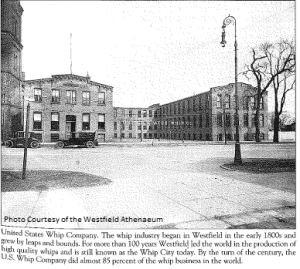 May 8, 1855: The whip manufacturing companies of H. Harrison and Hiram Hull merge to form the American Whip Company. Thirty eight years later the American Whip Company along with numerous other small whip interests in Westfield merge to establish the United States Whip Company, rendering Westfield’s whip industry the largest on the globe.
May 8, 1855: The whip manufacturing companies of H. Harrison and Hiram Hull merge to form the American Whip Company. Thirty eight years later the American Whip Company along with numerous other small whip interests in Westfield merge to establish the United States Whip Company, rendering Westfield’s whip industry the largest on the globe.
Westfield’s whip industry began in 1808, when Joseph Jokes discovered that quality hickory could be fashioned into whips. His prototype gained popularity in town and before long other entrepreneurs were marketing their own brand of horse whip. Each adapted his own technique of boiling and coloring oil. Initially Westfield whip-makers followed the English model, crafting the stock of holly and a replaceable lash to fit. Then during the 1830s whalebone was found to be a perfect substitute for hickory or white oak stocks, as its porous texture suited a whip’s function. As the industry expanded manufacturers continually sought alternative sources of raw materials like water buffalo or sheep, which provided rawhide for the center of the whip. Westfield ladies made a viable income through lash-braiding, an activity that could be performed out of the home by plaiting lengths of rawhide and weaving them together.

Hiram Hull, a Connecticut man who had relocated to Westfield, established his whip business in 1810, using women and girls as his primary labor force. After Hull appointed his son Liverus as his partner, the firm realized an even higher level of profit as Liverus obtained patents on his various machines for sewing rattan and other materials. Hull’s firm is credited with being the first to harness the possibilities of rattan; as the story goes, Hiram Hull was watching ships unload bundles of unused rattan at the port of New York (the rattan had been used for packing cargo) and snatched up the refuse. Between about 1855 and 1893 the United States Whip Company used six hundred tons of rattan annually and even housed rattan in its own processing facility.
Edward C. Janes and Roscoe S. Scott describe the prevalence of the whip in their book Westfield Massachusetts, 1669-1969: The First Three Hundred Years:
“At one time during the height of the whip era everybody, it seemed, carried a Westfield Whip. Farmers stocked them by the dozen. Business men ordered them especially made up with advertising slogans inscribed on the stock; professional men carried whips with carved ivory handles or with intricate workings of precious metals. Royalty and great American figures were presented with especially designed whips set with precious stones as tokens of esteem. But whether the design was simply or expensive all came from the same place, Westfield, Massachusetts. Lashes manufactured in the Whip City were considered perfection itself by rich and poor alike.”
As of 1968 Westfield still maintained two whip companies, one being the Westfield Whip Manufacturing Company owned by the former mayor of Westfield, Harold J. Martin. The latter company provided whips for stockyards and race tracks, carrying the whip into the present-day.

